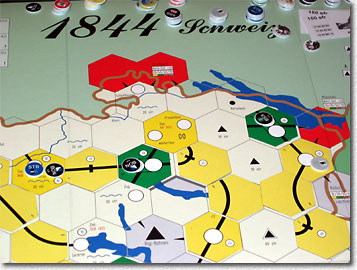
In time for Essen 2003 the 18xx family of railroad games, based on Francis Tresham's 1829, has received a new member: "1844 -Schweiz" for 3 to 7 players. Those not familiar with the 18xx games should have a look at our 18xx section if they want to learn more about the series.
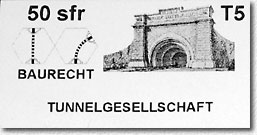
In 1844 the first railroad appeared in Switzerland and it ran from Strassbourg, France to Basel. Helmut Ohley, the author of 1844 made the effort to implement the scenario around the development of railroad companies during that time. Compared to other 18xx games the author designed a number of new ideas derived from the real setting in Switzerland. Due to the landscape Swiss railroad companies were forced to deal with many mountains and to cross the Alps and hence one of the new elements is that players are able build tunnels in the course of the game, which are operated by companies that generate dividends by themselves.
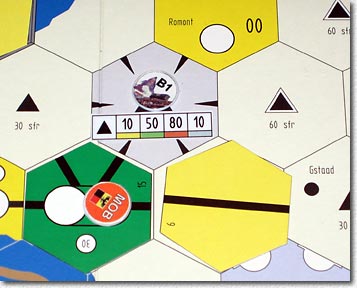
Another new concept is that of mountain railways, railroad companies that can be built on specially designated mountains and which, in terms of dividends, count like major cities for the other railroad companies. Mountain railways, too, generate their own income.
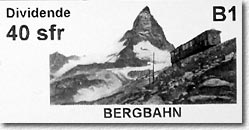
A concept taken over from 1826 is the H trains, which travel a number of hexes rather than a defined amount of cities/villages. Players can decide on which type of engine to buy for their corporations with H-type engines being slightly less expensive than the normal trains. Most engines now rust in two steps: normal engines become H-type and lower H-type engines disappear altogether. The largest engine available is the 8E, an electric engine which may skip the small villages on its route.
There are 7 private companies and 15 railroad corporations, 5 mountain railways and 5 tunnel companies. This makes it possible that even in a seven player game each player should be able to become director of at least one of the corporations. Like in 1835 four of the corporations will however unite to form the SBB major once the first 5 train has been bought. In addition, four regional corporations exist, which can only run H trains within Switzerland.
Overall, the larger amount of railroad corporations provides much more room for strategies and tactics but also make the game mechanics less transparent for new players. In particular, the fusion of the earlier corporations to become the SBB is something which I feel to be very demanding in terms of devising a proper strategy. Like in 1835 I always felt a bit out of control of the fate of an early corporation and the resulting success of the SBB. Anyway, the reduction of corporations in mid-game provides a tough decision base for all players.
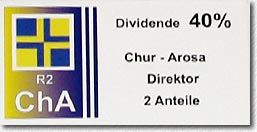
Another important fact is the distribution of shares across the corporation's certificates. Like in 1830, the major corporations have a 20% director's share and 8 10% shares. The small regional corporations have a 50% director's share and two 25% shares and the early corporations have a 40% director's share plus three 20% shares. Buying the director share of a regional is rather attractive as the corporation floats immediately and even an early corporation floats after only 2 certificates have been bought. The SBB comes with 5% certificates which make the corporation a favourite for stock manipulations in the end phase of the game.
The mechanism for handling the priority deal is a big improvement over 1830 since it eliminates many manipulation possibilities. Priority deal now goes to the player with the most money in hand, usually the least invested player.
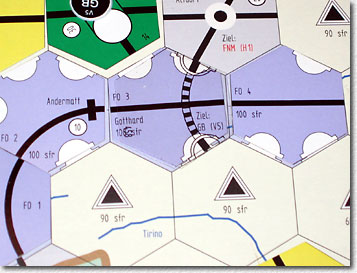
In order to achieve a track system that resembles history in its basic principles, each corporation has been asigned a target city. Once a route exists between the home town and the target city, the remaining 50% of the corporation's cash are paid to its treasury. While this is a nice mechanism to take care of history it yields track systems which are much more independent from each other than with for example in 1830. No fights for the best routes around Boston and New York here but rather a well organised, structured way of track building. In our game there was also no real fight with station markers as hardly any corporation had enough money to lay them in the mid and end phase of the game.
This shortage of corporation treasury is on the one hand caused by many mountains and rivers which need to be crossed and on the other hand by the constant need to buy trains. As opposed to other 18xx games one train is removed from the bank ("sold to a foreign country") after each set of operation rounds. This speeds up the game and makes it impossible for players to run a single engine for very long.
Especially the 5 and 6 trains rust too quickly and become (permanent) H trains with a rather limited range. This makes building large diesel type routes unnecessary and, due to the mountains, even unattractive. This may be historically correct but does not appeal to any empire building style of playing.
On the other hand, the game is much less cut throat as e.g. 1830. Villages have green tiles thus making the blocking of routes virtually impossible. And share prices drop by one field when shares are sold, independently of the number of shares sold, making stock scams much more unlikely.
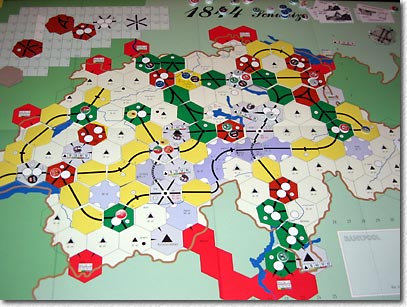
All in all, 1844 is a more than worthy member of the 18xx family. Helmut Ohley was able to blend the characteristics of the Swiss railroad system into the 18xx concepts very well and he managed to create a game with truly new and challenging mechanics. Switzerland as a setting provides enough possibilities for this. Game play is very balanced somewhere between empire building and cut throat stock market play. It appears that there are a lot less "extreme" situations where a game can tilt in favour or against a player, and ganging up on the leader seems to be more difficult, too.
A few words about the game material: looking at the professional quality of all components it is hard to believe that 1844 is produced as a private effort. Compared to Avalon Hill's 1830 the components are of far better quality and even when looking at the platinum edition of 1851 I still find that 1844 provides more value for money. And last but not least: it comes with a full featured rule book, not just a "difference list", which makes it a true standalone game suitable just as like for novices and experts of 18xx game series. Recommended!